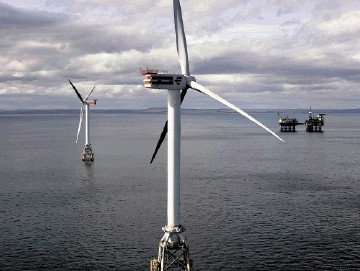
Scotland’s summer may have been a washout, but the wet and windy weather has proved to be a “belter” for renewable energy, with the amount of electricity produced by wind turbines up by more than 50% on last year.
Wind power alone supplied 660,117.23 Megawatt hours (MWh) of electricity to the National Grid in July, which is enough to supply on average the needs of 72% of Scottish homes – the equivalent of 1.75 million households.
That is up by 58% from the same month in 2014, according to environmental campaigners at WWF Scotland.
The body analysed data on wind and solar power from WeatherEnergy for the month of July, discovering that wind power alone generated more than a third of Scotland’s electricity needs for the month.
The amount of electricity used by homes, businesses and industry last month totalled 1,856,789.5MWh, with wind power producing 36% of this.
On eight days in July the amount of energy generated by wind turbines was sufficient to meet the needs every home in Scotland, WWF found.
The group’s Scotland director Lang Banks said: “It may have been amongst one of the wettest and windiest months in decades, but July also turned out to be a belter of a month for wind power in Scotland.
“Thanks to a combination of increased capacity and much windier weather, output from turbines was up more than half compared to the same period last year – supplying power equivalent to the electrical needs of 1.75 million homes.”
Despite the wet weather, there was enough sunshine to allow homes with solar PV panels to generate 94% of the average electricity need in Aberdeen, compared to 87% in Inverness, 85% in Edinburgh and 79% in Glasgow.
Meanwhile for homes which use solar power to heat their water, the sunshine could have generated 92% of an average home’s hot water needs in Aberdeen, compared to 87% in Inverness, 85% in Edinburgh and 74% in Glasgow.
Mr Banks said: “Despite the clouds and overcast skies, for tens of thousands of homes that have installed solar panels to generate electricity or heat water, around four-fifths of their electricity or hot water needs could have been met by the sun. This all helped Scotland to further reduce its reliance on polluting fossil fuels during July.”
The data was released as US president Barack Obama moved ahead with even tougher greenhouse gas cuts, aiming to cut carbon dioxide emissions by 32% by 2030 from the 2005 levels.
Mr Banks said: “Improving energy efficiency and embracing renewables is what is what is going to take the world one step closer to addressing the challenge of global climate change.
“It’s therefore great to see President Obama follow Scotland’s lead and throw his weight behind more renewables in the US. It sends a very powerful message globally that more politicians need to get right behind green energy.”
SNP MSP Mike Mackenzie said: “These outstanding new figures are a welcome demonstration of the growing strength of Scotland’s renewables industry, with a 58% boost on the previous year’s figure showing the incredible strides Scotland is making in producing clean, sustainable energy – and confirming the vital role green energy can play in meeting our energy needs.”.
Mr Mackenzie, who has put forward a motion to the Scottish Parliament condemning the UK Government’s decision to end a subsidy scheme for on-shore wind projects early, added: “This is exactly why the UK Government’s decision to cut onshore wind subsidies funded through the Renewables Obligation is so dangerous.”
He claimed the move could “see a loss of investment of up to £3 billion, put more than 5,000 jobs at risk and endanger the excellent progress Scotland has made on renewables in recent years”.
Mr Mackenzie added: “These latest figures show that Scotland has a real opportunity to be a world leader on renewable energy – which can boost our economy, create jobs and protect the environment.
“Our excellent progress must not be put at risk by the reckless and regressive approach of a Tory government with scant regard for Scotland’s interests.”
Recommended for you
